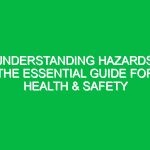Introduction
In today’s complex industrial landscape, effective communication regarding Hazards is essential for maintaining Safety and health in the workplace. Hazard communication symbols play a pivotal role in this context. These symbols serve not only as visual aids but also as an integral part of the Health, Safety, and Environment (HSE) framework, ensuring that workers are informed of the risks associated with the materials and processes they encounter. Understanding these symbols is vital for fostering a culture of Safety, preventing accidents, and ensuring compliance with Regulations.
This article delves into the world of Hazard Communication symbols, exploring their significance, the regulations governing them, and practical insights for their effective implementation. We will also examine real-life applications and scenarios that highlight their importance in the HSE domain.
The Importance of Hazard Communication Symbols
Hazard communication symbols are standardized graphics that convey information about the Hazards present in substances or environments. These symbols are designed to be easily recognizable, transcending language barriers and providing immediate understanding of potential dangers. For instance, the skull and crossbones symbol universally indicates the presence of toxic substances, alerting individuals to proceed with caution.
The significance of these symbols cannot be overstated. They empower workers to make informed decisions about their safety and health. Additionally, these symbols are crucial for emergency responders, who rely on them to quickly assess risks in hazardous situations. In essence, hazard communication symbols are not just images; they are lifelines that facilitate Safe Practices in various industries.
Key Components of Hazard Communication Symbols
Understanding the components and classifications of hazard communication symbols is essential for their effective use. The Globally Harmonized System of Classification and Labelling of Chemicals (GHS) has standardized these symbols, allowing for consistency across different regions and industries. Each symbol is accompanied by a signal word—either “Danger” or “Warning”—that denotes the severity of the hazard.
Categories of Hazard Communication Symbols
- Physical Hazards: These symbols indicate risks such as flammability, reactivity, and explosive potential. For example, a flame symbol denotes a flammable material.
- Health Hazards: These symbols represent dangers that can affect health, such as carcinogenicity or respiratory sensitization. The exclamation mark symbol is a general warning for various health risks.
- Environmental Hazards: These symbols inform users about substances that can harm the environment, such as aquatic toxicity. The dead fish and tree symbol is an example of this category.
Each category encompasses various symbols that provide specific information about the hazard. Familiarizing oneself with these categories is crucial for proper hazard assessment and management.
Real-Life Applications and Scenarios
To illustrate the practical implications of hazard communication symbols, consider the case of a chemical manufacturing plant. In this facility, various chemicals are stored and processed, each posing different risks. The plant uses hazard communication symbols on labels and signage to ensure that all employees and visitors are aware of the potential dangers.
For example, a worker in the facility may come across a container labeled with a corrosive symbol. This visual cue alerts them to the need for Personal Protective Equipment (PPE) such as gloves and goggles before handling the substance. Additionally, during an emergency drill, first responders can identify the presence of hazardous materials quickly by referring to the symbols displayed on the containers. This rapid recognition can significantly impact the effectiveness of emergency response efforts.
Another example can be drawn from a construction site. Workers may encounter various materials, such as adhesives or solvents, that carry hazard communication symbols indicating flammability or toxicity. By understanding these symbols, the crew can take appropriate Precautions, such as ensuring adequate ventilation or keeping ignitable materials away from heat sources.
Regulations and Standards Governing Hazard Communication Symbols
The use of hazard communication symbols is governed by various regulations designed to protect workers and the environment. In the United States, the Occupational Safety and Health Administration (OSHA) establishes guidelines for hazard communication under the Hazard Communication Standard (HCS). This standard requires that all hazardous chemicals be labeled with appropriate symbols and that Safety Data Sheets (SDS) are provided to inform employees of the hazards associated with these chemicals.
Similarly, the GHS, adopted by many countries worldwide, provides a framework for classifying and labeling chemicals. The GHS aims to harmonize the classification of chemicals globally, enhancing safety and reducing confusion caused by varying labeling practices.
Compliance with these regulations is not merely a legal obligation; it is a moral responsibility that employers must uphold to safeguard their workforce. Failure to adhere to these standards can result in severe penalties and, more importantly, jeopardize the health and safety of employees.
Best Practices for Implementing Hazard Communication Symbols
Implementing hazard communication symbols effectively requires a systematic approach. Here are some Best Practices to consider:
1. Training and Education
Training employees on the meaning and significance of hazard communication symbols is essential. Regular Training sessions should be conducted to ensure that all staff members understand the symbols relevant to their work environment. This training will empower employees to recognize potential hazards and take appropriate Precautions.
2. Clear Labeling
Labels should be clear, legible, and prominently displayed. Employers should ensure that all hazardous materials are properly labeled with the correct hazard communication symbols, signal words, and precautionary statements. Regular audits can help in identifying any labeling discrepancies.
3. Safety Data Sheets (SDS)
Employers must provide accessible Safety Data Sheets for all hazardous materials. SDS contain comprehensive information about the chemical, including its hazards, safe handling practices, and emergency response measures. Employees should be trained on how to read and interpret SDS effectively.
4. Regular Reviews and Updates
It is vital to conduct regular reviews of hazard communication practices and update them as necessary. This includes staying informed about changes in regulations and ensuring that new symbols or classifications are incorporated into the Workplace Safety program.
Addressing Potential Risks and Safety Considerations
While hazard communication symbols are crucial for promoting safety, they are not foolproof. Misinterpretation or lack of awareness can lead to accidents. For instance, if a worker misreads a label and fails to wear appropriate PPE, they may expose themselves to harmful substances.
To mitigate such risks, organizations should foster a culture of safety where employees feel empowered to ask questions and seek clarification about hazards. Regular safety meetings and open communication channels can enhance understanding and vigilance regarding hazard communication symbols.
Conclusion
In conclusion, hazard communication symbols are an indispensable part of the health, safety, and environmental landscape. They serve as crucial tools for conveying hazards effectively, protecting workers, and ensuring compliance with regulations. By understanding and implementing these symbols correctly, organizations can foster a safer work environment and prevent accidents.
As we navigate an increasingly complex industrial world, the importance of hazard communication symbols will only grow. Employers and employees alike must remain vigilant, informed, and proactive in their approach to hazard recognition and communication. By doing so, we can create a culture that prioritizes safety and well-being for everyone involved.


